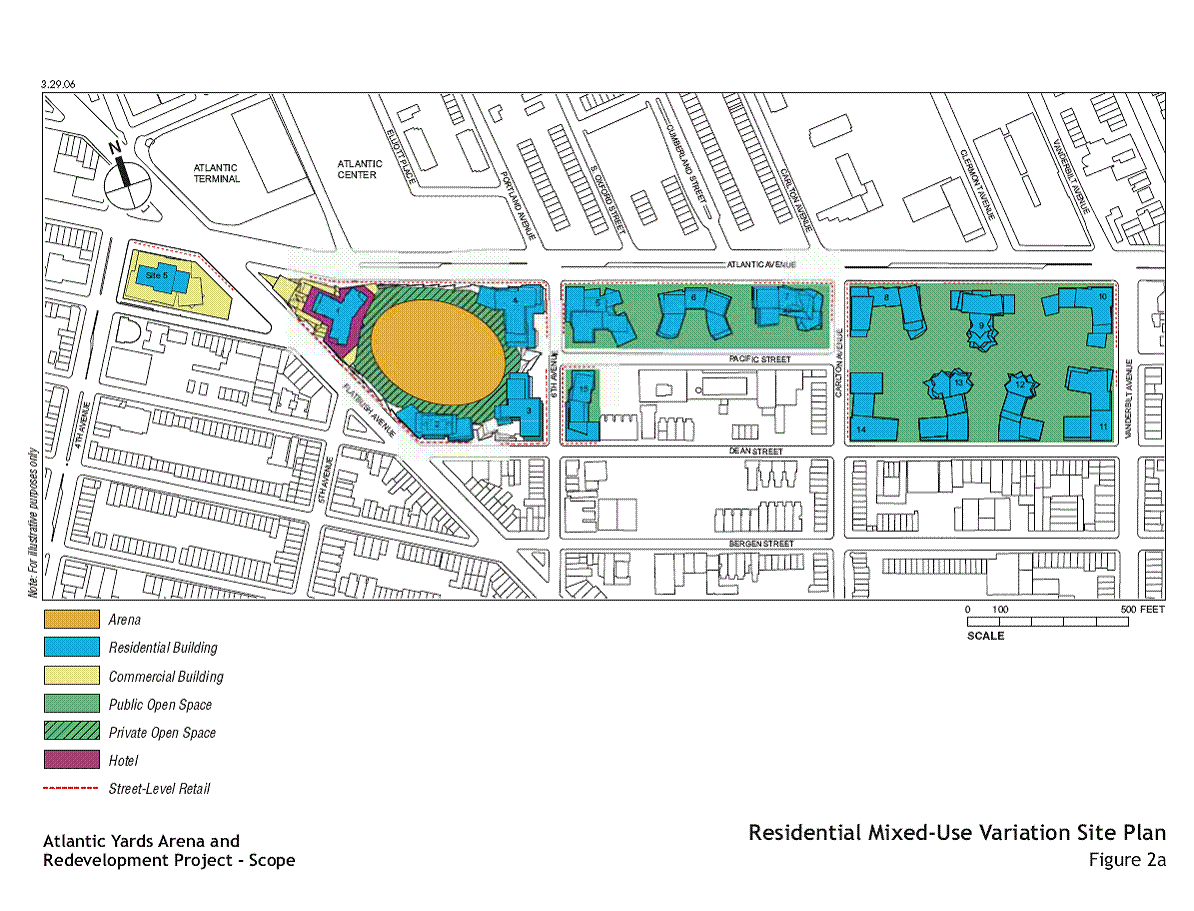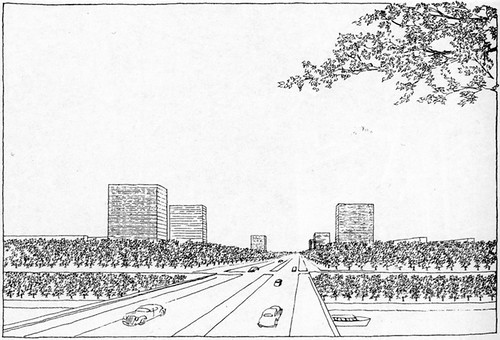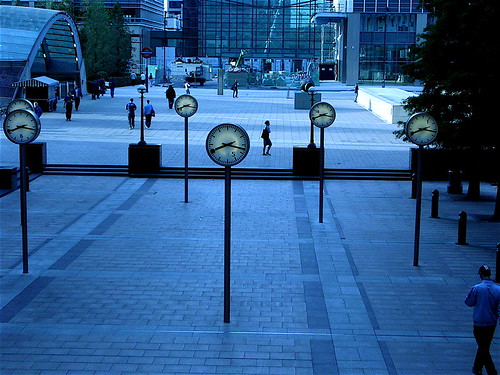not so superblock
In an interview with the New York Observer several months ago, the Atlantic Yards' landscape architect Laurie Olin dismisses the common stigma against superblocks as clichéd "1960s language." His own arguments for them, however, echo the naïve idealism of planners from that very era. "If I put a street through here," he states, "[then] I have less space for people and I have more cars… When people say 'superblock'— what's wrong with what this is? Because I don't see how adding one car in here is going to make it a better space. I think space on streets is actually useless space."
 The current plan for Atlantic Yards involves the demapping of several streets and the creation of a residential superblock. Site Plan via Atlantic Yards Report.
The current plan for Atlantic Yards involves the demapping of several streets and the creation of a residential superblock. Site Plan via Atlantic Yards Report.
The superblock, put very simply, is a development form larger than a traditional city block. According to civic-minded urban theorists in the mid-20th century, residents of superblocks would be liberated from cars in their everyday life, living freely as denizens of self-sufficient pedestrian communities. The scale of these superblocks, wrote Bauhaus urban planner Ludwig Hilberseimer, would allow them to "preserve an organic community life" in the face of automobile-based cities of the future. (The Nature of Cities, 1955.)
 Concept for Heerstrasse and University of Berlin, 1937. Ludwig Hilberseimer. Scanned from The American City: What Works, What Doesn't by Alexander Garvin. Hilberseimer worked with Mies van der Rohe on the United States' most successful superblock project: Lafayette Park in Detroit.
Concept for Heerstrasse and University of Berlin, 1937. Ludwig Hilberseimer. Scanned from The American City: What Works, What Doesn't by Alexander Garvin. Hilberseimer worked with Mies van der Rohe on the United States' most successful superblock project: Lafayette Park in Detroit.
In practice, completed superblock projects rarely approach Hilberseimer's utopian vision: for the most part, superblock projects are boring and institutional. At worst, the designs encourage crime and neglect.
The NYU Silver Towers project north of Houston between Mercer and LaGuardia demonstrates the detrimental effect that the demapping of streets to create superblocks can have on the public realm. Despite an elegant design by I.M. Pei and a plaza with public art by Picasso, the modest superblock is a dead zone in the Village's otherwise vibrant public realm. Compared to neighboring SoHo – which has streets filled with a jumble of people and uses – the Silver Towers are a public realm failure.
 NYU’s Silver Towers, a superblock created by the demapping of Wooster and Greene Streets, lacks the vitality of the smaller blocks that surround it. Photo by Hubert Steed.
NYU’s Silver Towers, a superblock created by the demapping of Wooster and Greene Streets, lacks the vitality of the smaller blocks that surround it. Photo by Hubert Steed.
With the rise of New Urbanism and the canonization of Jane Jacobs, superblocks became a sort of urban design taboo – the quintessential example of high-minded architectural theory failing in real world application. Thus of the myriad flaws in the plan for Ratner's Atlantic Yards development in Brooklyn, perhaps the most surprising, from a design perspective, is its return to the superblock form. In the words of the Manhattan Institute's Julia Vitullo-Martin, "Do we not all agree with Jane Jacobs that the urbane mixtures of buildings of varying age, condition—inevitably swept away by the superblock—are a necessary condition of thriving urban life?"
Apparently not.
One dissenter, it seems, is Olin. In the past, Olin has demonstrated an incredible ability to create beautiful public space enclaves in crowded urban environments. At the Getty Center in L.A., he worked with Richard Meier to create a hilltop oasis for art; at Bryant Park, he collaborated with William Whyte to carve a cozy community park from the mind-boggling intensity of Midtown Manhattan.
 Bryant Park. Photo from Forgotten NY.
Bryant Park. Photo from Forgotten NY.
Unfortunately, Olin's talents do not always translate well into projects meant to integrate into the fabric of the city, rather than stand out from it. At Canary Wharf in London – like Atlantic Yards, a mixed-use high-rise development on a post-industrial site – the public spaces planned by Olin are impersonal and lack activity. Despite crowds of people working in the area, the wharf's public spaces are often nearly deserted. (It's said that the Radiohead's Fake Plastic Trees is about Canary Wharf, even though the trees are real. For more criticism, see the Project for Public Space’s Hall of Shame.)
 Canary Wharf Tube Station, London, U.K. Image from yuki*.
Canary Wharf Tube Station, London, U.K. Image from yuki*.
In the chapter of The Death and Life of Great American Cities entitled "The Need for Small Blocks," Jacobs bemoans the "myth that plentiful streets are 'wasteful.'" She argues that it is, in fact, large blocks that lead to wasted space by constricting "economic use [to] only where [people's] long, separated paths meet and come together in one stream." The consolidation of economic activity to confined geographic areas leads to a "depressing predominance of commercial standardization... [and] the Great Blight of Dullness." Ultimately, it is the presence of streets where things can "start up and grow" that lead to economic vitality and vibrant public space.
 Potential pedestrian paths on large blocks (left) vs. potential pedestrian paths on short blocks (right.) From The Death and Life of Great American Cities, by Jane Jacobs.
Potential pedestrian paths on large blocks (left) vs. potential pedestrian paths on short blocks (right.) From The Death and Life of Great American Cities, by Jane Jacobs.
In his defense of the Atlantic Yards superblock, Olin ignores the lessons of Jacobs while also revealing a fundamental misunderstanding of Brooklyn's streets. In vibrant neighborhoods like those surrounding Atlantic Yards, streets are more than a means of reaching a destination: they are the destinations themselves. Besides providing a place for cars to drive, Brooklyn's streets host a diversity of restaurants, stores, and cultural institutions – all of which serve customers arriving via public transportation or on foot. Moreover, the borough often closes its avenues completely to traffic to host festivals and fairs, events that have helped to give Brooklyn the value that Ratner, the Atlantic Yards' developer, is so eager to capitalize on. By asserting that "space on streets is actually useless space," Olin demonstrates a profound ignorance regarding Brooklyn's urban form.
 The Atlantic Antic, Brooklyn, NY. (This festival takes place on Atlantic Avenue -- the northern limit of the of the Atlantic Yards development.) Photo from Apollonia666.
The Atlantic Antic, Brooklyn, NY. (This festival takes place on Atlantic Avenue -- the northern limit of the of the Atlantic Yards development.) Photo from Apollonia666.
Perhaps what is most surprising about the Atlantic Yards' superblock plans isn't the designers' defense of the concept, but the support it has from its developer. Small blocks, Jacobs makes it clear, are better for business. If he knew better, Ratner would be pushing for more streets – not fewer. Indeed, the superblock is neither a pedestrian-friendly design statement nor a wise investment – it's just a mistake.
 The current plan for Atlantic Yards involves the demapping of several streets and the creation of a residential superblock. Site Plan via Atlantic Yards Report.
The current plan for Atlantic Yards involves the demapping of several streets and the creation of a residential superblock. Site Plan via Atlantic Yards Report.The superblock, put very simply, is a development form larger than a traditional city block. According to civic-minded urban theorists in the mid-20th century, residents of superblocks would be liberated from cars in their everyday life, living freely as denizens of self-sufficient pedestrian communities. The scale of these superblocks, wrote Bauhaus urban planner Ludwig Hilberseimer, would allow them to "preserve an organic community life" in the face of automobile-based cities of the future. (The Nature of Cities, 1955.)
 Concept for Heerstrasse and University of Berlin, 1937. Ludwig Hilberseimer. Scanned from The American City: What Works, What Doesn't by Alexander Garvin. Hilberseimer worked with Mies van der Rohe on the United States' most successful superblock project: Lafayette Park in Detroit.
Concept for Heerstrasse and University of Berlin, 1937. Ludwig Hilberseimer. Scanned from The American City: What Works, What Doesn't by Alexander Garvin. Hilberseimer worked with Mies van der Rohe on the United States' most successful superblock project: Lafayette Park in Detroit.In practice, completed superblock projects rarely approach Hilberseimer's utopian vision: for the most part, superblock projects are boring and institutional. At worst, the designs encourage crime and neglect.
The NYU Silver Towers project north of Houston between Mercer and LaGuardia demonstrates the detrimental effect that the demapping of streets to create superblocks can have on the public realm. Despite an elegant design by I.M. Pei and a plaza with public art by Picasso, the modest superblock is a dead zone in the Village's otherwise vibrant public realm. Compared to neighboring SoHo – which has streets filled with a jumble of people and uses – the Silver Towers are a public realm failure.
 NYU’s Silver Towers, a superblock created by the demapping of Wooster and Greene Streets, lacks the vitality of the smaller blocks that surround it. Photo by Hubert Steed.
NYU’s Silver Towers, a superblock created by the demapping of Wooster and Greene Streets, lacks the vitality of the smaller blocks that surround it. Photo by Hubert Steed.With the rise of New Urbanism and the canonization of Jane Jacobs, superblocks became a sort of urban design taboo – the quintessential example of high-minded architectural theory failing in real world application. Thus of the myriad flaws in the plan for Ratner's Atlantic Yards development in Brooklyn, perhaps the most surprising, from a design perspective, is its return to the superblock form. In the words of the Manhattan Institute's Julia Vitullo-Martin, "Do we not all agree with Jane Jacobs that the urbane mixtures of buildings of varying age, condition—inevitably swept away by the superblock—are a necessary condition of thriving urban life?"
Apparently not.
One dissenter, it seems, is Olin. In the past, Olin has demonstrated an incredible ability to create beautiful public space enclaves in crowded urban environments. At the Getty Center in L.A., he worked with Richard Meier to create a hilltop oasis for art; at Bryant Park, he collaborated with William Whyte to carve a cozy community park from the mind-boggling intensity of Midtown Manhattan.
 Bryant Park. Photo from Forgotten NY.
Bryant Park. Photo from Forgotten NY.Unfortunately, Olin's talents do not always translate well into projects meant to integrate into the fabric of the city, rather than stand out from it. At Canary Wharf in London – like Atlantic Yards, a mixed-use high-rise development on a post-industrial site – the public spaces planned by Olin are impersonal and lack activity. Despite crowds of people working in the area, the wharf's public spaces are often nearly deserted. (It's said that the Radiohead's Fake Plastic Trees is about Canary Wharf, even though the trees are real. For more criticism, see the Project for Public Space’s Hall of Shame.)
 Canary Wharf Tube Station, London, U.K. Image from yuki*.
Canary Wharf Tube Station, London, U.K. Image from yuki*. In the chapter of The Death and Life of Great American Cities entitled "The Need for Small Blocks," Jacobs bemoans the "myth that plentiful streets are 'wasteful.'" She argues that it is, in fact, large blocks that lead to wasted space by constricting "economic use [to] only where [people's] long, separated paths meet and come together in one stream." The consolidation of economic activity to confined geographic areas leads to a "depressing predominance of commercial standardization... [and] the Great Blight of Dullness." Ultimately, it is the presence of streets where things can "start up and grow" that lead to economic vitality and vibrant public space.
 Potential pedestrian paths on large blocks (left) vs. potential pedestrian paths on short blocks (right.) From The Death and Life of Great American Cities, by Jane Jacobs.
Potential pedestrian paths on large blocks (left) vs. potential pedestrian paths on short blocks (right.) From The Death and Life of Great American Cities, by Jane Jacobs.In his defense of the Atlantic Yards superblock, Olin ignores the lessons of Jacobs while also revealing a fundamental misunderstanding of Brooklyn's streets. In vibrant neighborhoods like those surrounding Atlantic Yards, streets are more than a means of reaching a destination: they are the destinations themselves. Besides providing a place for cars to drive, Brooklyn's streets host a diversity of restaurants, stores, and cultural institutions – all of which serve customers arriving via public transportation or on foot. Moreover, the borough often closes its avenues completely to traffic to host festivals and fairs, events that have helped to give Brooklyn the value that Ratner, the Atlantic Yards' developer, is so eager to capitalize on. By asserting that "space on streets is actually useless space," Olin demonstrates a profound ignorance regarding Brooklyn's urban form.
 The Atlantic Antic, Brooklyn, NY. (This festival takes place on Atlantic Avenue -- the northern limit of the of the Atlantic Yards development.) Photo from Apollonia666.
The Atlantic Antic, Brooklyn, NY. (This festival takes place on Atlantic Avenue -- the northern limit of the of the Atlantic Yards development.) Photo from Apollonia666.Perhaps what is most surprising about the Atlantic Yards' superblock plans isn't the designers' defense of the concept, but the support it has from its developer. Small blocks, Jacobs makes it clear, are better for business. If he knew better, Ratner would be pushing for more streets – not fewer. Indeed, the superblock is neither a pedestrian-friendly design statement nor a wise investment – it's just a mistake.

18 comments:
great post. i think it's really the lack of commercial activity that kills the superblock. if the NYU buildings had significant retail on their ground floors, the area would be buzzing with activity.
also combined with washington sq village just north of it creates an even larger dead zone.
for the superblock to work, it should have plenty of pedestrian entryways and it should be in some way a destination itself. the wtc superblock would have been great had the plaza not been raised up so high from street level.
Great post, and I agree with j$.
It's so simple--it's right out of elementary chemistry: more surface area allows more stuff to happen.
If you cut up a superblock with pedestrian throughways, that increases "surface area" of the institition. If you allow commercial activity there, that creates a destination. Access to pedestrians, combined with places pedestrians will actually go to, will prevent the "dead zone" effect.
I also agree and think it is a great post.
But I would add that this is probably not a theoretical question. I suspect the developers came up with the site, and then hired Gehry to design the buildings and Olin to design the landscaping. I suspect it is a superblock because it is a super-large development, and Olin's theorizing is just an after-the-fact rationalization.
I lived right there at the NYU "superblock", and this post is 100% on the mark. Downtown ATL sucks, and superblocks are part of the problem, with those big hotels dominating with their concrete ugliness.
Agreed with all of the above. A great post on a subject I didn't know that much about. How do we get this post and, more importantly, this topic more attention?
Awesome thoughtful commentary. i'd like to link to your site on mine.
http://moot2moot.blogspot.com
Great blog! Merry Christmas!
Aaron Naparstek of Streetsblog is a facist. He only publishes comments which aree with his point of view. If you have anything contrary to say, no matter how you say it, you will be deleted.
Have you seen the film American Gangster with Denzel Washington and Russel Crow? In the movie, the building placed in Harlem where the drug is distributed is a horrible superblock. Indeed, the relation between criminality and superblocks is clear.
We tried a variation on this theme in Pittsburgh, Pa. Turned the East Liberty "downtown" commercial and residential area into a pedestrian-only "walking mall".
Small business's died in droves. People simply would not do that much walking to transact everyday business, like food shopping or buying shoes.
The area is still trying to recover, 20 or so years later.
This sounds great on paper, but people don't seem to like this sort of thing very much in real life.
This was a very thoughtful post. All the readers that argue for commercial installations at grade level are correct. NYU's plaza is also a private area only for their tower's residents and offers no walkway to Houston Street (the main pedestrian thoroughfare). That is another reason it is always barely occupied.
Superblocks can be vibrant however as was the case many years ago in Co-Op City. Poor maintenance by the development owners caused the deterioration of the public's use of those open spaces.
My vision for the Atlantic Yards redevelopment has the Nets moving out to Newark to co-tenant the existing arena there and for affordable business space to be created in the wake of the voluminous void the arena space leaves behind.
Instead of all of these DIY Brooklynites working from inside of their homes maybe we can allow them to increase their quality of life by running their PR/graphics business from an affordable office space. All we need now are a few coffee and sandwich shops at the ground level and maybe we have achieved what the Metrotech development could not.
Though at the end of the day large open spaces are unfortunately too communistic.
http://ecoworld.forumotion.com/portal.htm
Man, I just adore Built Environment Blog. I am an archaeologist practicing as a heritage consultant in New South Wales (Australia). I am involved in providing advice to local councils in regional areas on heritage conservation and urban design.
I find the blog intelligent, stimulating and just plain intoxicating.
I know the energy that goes into maintaining blogs and understand you not posting much - but PLEASE keep it up.
not much i can add to whats been said already, except to say it was an excellent thoroughly written post.
easy to say of course, that space on the street is wasted if you don't actually have to live there! it may not not be a nescessity to be able to hang around and socialise on the street, but the fact is it makes life much more agreeable and humane, as has been proved time and time again.
I agreed with all comments here. Great idea....i think it could be nice if my government can implement this "not so superblock" in my dangerously beautiful country, Indonesia.
Thank you for the great post, interesting. I have never been to these cities and actually experienced what it's like to live and work in a world like that, of surrounding skyscrapers and masses of people walking from place to place, I CAN say, tho, that I would think that without the "open" areas like parks and cafe's, etc. where people can walk freely and congregate, would make for an absolutely depressing area to live and work in!
Nice post but it leaves me with a big question as to if it will and can happen...
Post a Comment